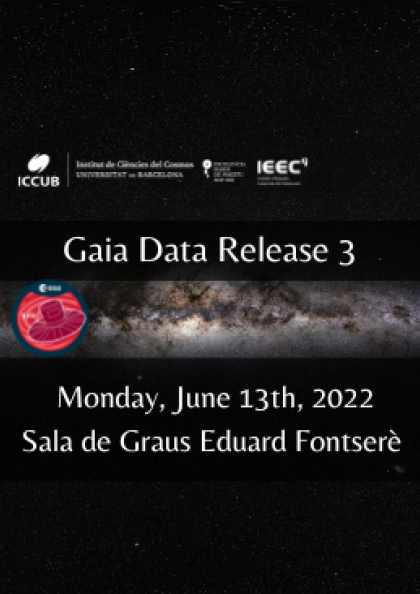Gaia DR3: Activities’ programme
Gaia Data Release 3 (Gaia DR3) will be made public next Monday, 13 June 2022. The data will become available through the Gaia Archive (and through the partner data centres). The Gaia DR3 catalogue builds upon the Early Data Release 3 (released on 3 December 2020) and combines, for the same stretch of time and the same set of observations, these already-published data products with numerous new data products such as extended objects and non-single stars.
The Gaia group at the Institute of Cosmos Sciences of the University of Barcelona and Institute of Space Sciences of Catalonia (ICCUB-IEEC) wants to share this historic event with the scientific community and the general public and has prepared a series of acts to bring this new data catalogue to you. Find here the activities’ programme of the day:
OPENING ACT: GAIA DR3, THE ICCUB CONTRIBUTION AND FIRST SCIENCE RESULTS
10:40: Gaia DR3 and the role of the ICCUB team (J. Portell)
11:00: Gaia DR3 science results: verification papers in a nutshell (X. Luri)
11:20: Questions
When? From 10:30 to 11:20h
Where? Sala de Graus Eduard Fontserè, Physics Faculty
Language English
LIVE RETRANSMISSION: OPENING OF THE GAIA ARCHIVE AT ESAC
When? From 12 to 13h
Where? Live-streaming of central act in ESAC from the Sala de Graus Eduard Fontserè, Physics Faculty
Language English
COLLOQUIUM-DEBATE: “GAIA EN TUS MANOS (CAPÍTULO 3)”
When? From 16:30 to 18:40h
Where? YouTube live
Language Spanish
OUTREACH TALK: “GAIA DR3: DESCUBRIENDO MÁS SECRETOS DE LA GALAXIA”
When? From 19 to 20h
Where? YouTube live
Language Spanish
Gaia UB
The experience of our group at the University of Barcelona (IEEC – ICCUB) in the space sector begins with the satellite Hipparcos (1989-1993). Our group has contributed since its inception in the concept of the Gaia mission and design. Our team has a major role in the development of the simulations, the initial processing and photometric data from the mission.
The team consists of around 30 people, including scientists and engineers, ranging from software development to data management, as its monitoring and scientific validation. The Data Processing Center of Barcelona also led by our team, coordinates the operation of the heaviest part of the reduction of operational data in the Marenostrum (Barcelona Supercomputing Center BSC-CNS) and CSUC.
